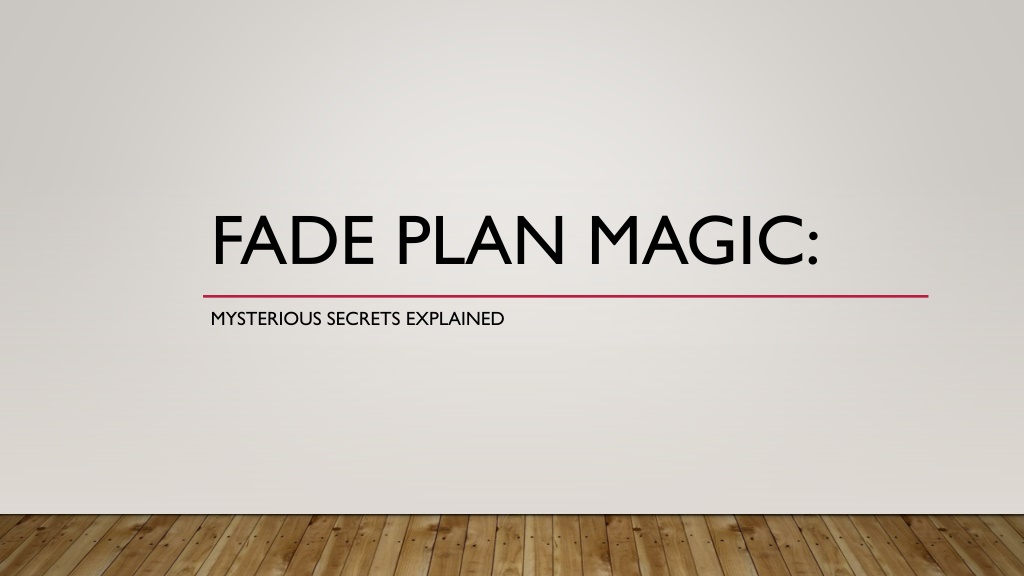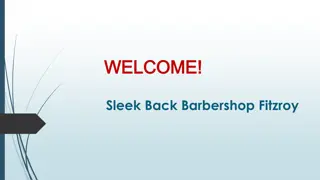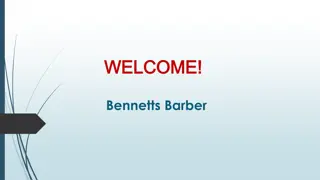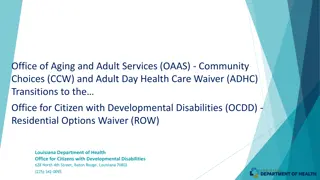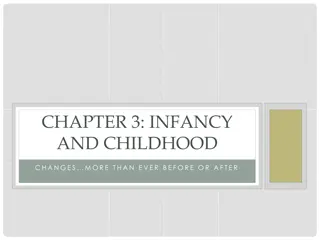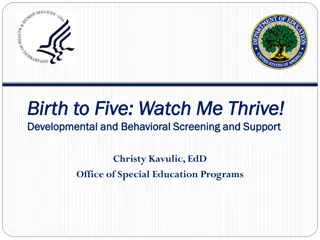Understanding and Implementing Fade Plans for Developmental Services
Explore the concept of fade plans in the context of developmental services, focusing on gradually reducing restrictive interventions and enhanced staffing while promoting new skills and behaviors. Learn about the importance of starting the fade process at the smallest feasible interval and tailoring the plan to individual needs. Gain insights into fading strategies, criteria for success, and review processes to support individuals in achieving independence and success within their communities.
Download Presentation

Please find below an Image/Link to download the presentation.
The content on the website is provided AS IS for your information and personal use only. It may not be sold, licensed, or shared on other websites without obtaining consent from the author. Download presentation by click this link. If you encounter any issues during the download, it is possible that the publisher has removed the file from their server.
E N D
Presentation Transcript
FADE PLAN MAGIC: MYSTERIOUS SECRETS EXPLAINED
DEPARTMENT OF DEVELOPMENTAL SERVICES MISSION STATEMENT The mission of the Department of Developmental Services is to partner with the individuals we support and their families, to support lifelong planning and to join with others to create and promote meaningful opportunities for individuals to fully participate as valued members of their communities.
FADE PLAN RATIONALE Restrictive Interventions and Enhanced Staffing are inherently temporary measures that are put in place to maintain health and safety while teaching new skills and replacement behaviors. All Restrictive interventions and enhanced staffing patterns require a fade plan.
FADING KNOWS NO BOUNDS! Always start the fade at the smallest feasible time interval that can safely be successful. In the environment that will most likely be successful. During the time of day that will most likely be successful. Finding the tiniest feasible moment that can reduce/relax a restrictive intervention can highlight to the team that this individual can have a taste of success.... and with success/independence, build from there!
FADE PLANS FOR ENHANCED STAFFING A fade needs to be like a light switch. It needs to be either "on" or "off." We need to ask ourselves "Can this person be successful for any length of time with the regular staffing ratio and can the staff assigned to the group remain successful in redirecting the target behaviors which serve as the rationale for the enhanced staffing". If a person is not in a place to fade into a group setting, you can start with a reduction of proximity guidelines. The fade plan should be tied to the rationale for enhanced staffing. For example, if the individual has enhanced staffing due to high levels of aggression, the fade should be tied to lack of aggression during the fade time. The fade cannot simply say "target behaviors" render the fade unsuccessful. The target behavior that renders the fade unsuccessful must be the target behavior that is tied to the rationale for the enhanced staffing. In this example, if someone has 1:1 staffing due to high levels of aggression, the success of the fade cannot be tied to a target behavior of perseveration ( or any other target other than aggression). Start with an interval of time that is agreed upon by the Indvidual's support team. The interval should be short enough so that success is possible. Determine what percentage of success for each month would qualify for an increase in the fade interval for the next month, or whatever timeline is determined appropriate to begin the next step of the fade. Specify the criteria for fading measures to be used in a written plan for fading Include information about who will review progress on this fade plan and how often to review.
FADE PLANS FOR ENHANCED STAFFING To correctly run a fade for enhanced staffing, the individual would no longer be receiving enhanced staffing during the fade interval. The 1:1 is responsible for documenting success or failure, however, this person is not interacting with the individual and should be far enough away to not act as a prompt of any kind (ideally out of line of sight), but close enough to intervene if health or safety is at risk. (A nuanced, but important point!) Fades should be run during the time of day that would be the most successful for the individual. For example, if the individual struggles during the morning hours but is typically on task in the afternoon, the fade should be scheduled for the afternoon. (Look at the data for trends!) Determine what criterion needs to be met in order for the fade to be considered successful, and what would be considered unsuccessful. Be prescriptive so that the staff running the fade know exactly what to look for. Does the fade end immediately upon target behavior display? How many prompts from the group staff to discontinue target behavior display would qualify as non-success and end the fade for that specific trial. Is the team looking to see positive behaviors take place during the fade or simply the absence of maladaptive behaviors. Fades for enhanced staffing should be run daily. Each time a fade is run, documentation of success / non-success should be done. Once your fade hits an extended amount of time, you can break them up into smaller intervals throughout the day. (or if it will lead to increased success based on the programming schedule) For example, we have someone currently fading 90 minutes per day so we do his fade in two separate 45 minute intervals.
EXAMPLES OF ENHANCED STAFFING FADE PLANS Individual DF has enhanced staffing due to the frequency and intensity of his Physical and Environmental Aggression. Fade Plan: DF will be staffed as a part of the small group for an interval of time daily. Starting interval: 15 minutes. Time of Fade: 9:15am Criteria for Success: DF will refrain from displaying Physical and Environmental Aggression while being staffed as a part of the small group. Criteria for Increase: Following 85% success of all opportunities in a month,interval will increase by 15 minutes. How to complete the fade: DF will be staffed as a part of the small group. During the fade interval, his 1:1 will no longer follow the written supervision guidelines and DF will be under the supervision of the group staff NOT his assigned 1:1. 1:1 is to remain in the same room during the fade. If at any time during the fade DF begins to display Physical or Environmental Aggression, his 1:1 will immediately step in to intervene and the fade is over.
EXAMPLES OF ENHANCED STAFFING FADE PLANS Individual ZP has enhanced staffing due to the frequency of Aggression, Self-Inflicted behaviors, and inability to remain On Task without frequent intervention from staff members. Fade plan: ZP will be staffed as a part of the small group for an interval of time daily. Starting interval: 5 minutes. Time of fade: 1pm Criteria for Success: ZP will refrain from displayingAggression and / or Self-Inflicted behaviors AND remain On Task. If ZP displaysAggression / Self Inflicted behaviors the fade immediately ends and is considered unsuccessful for the day. ZP can be given 2 prompts or less to remain On Task. If ZP requires 3 or more prompts the fade ends and is considered unsuccessful. Criteria for Increase: Following 85% success of all opportunities in one month, the interval will increase by 5 minutes. How to Complete the Fade: ZP will be under the supervision of the small group staff. His assigned 1:1 staff member will no longer follow the written supervision guidelines but must remain in the room and oversee the fade. If ZP begins to engage inAggression and / or Self-Inflicted behavior his 1:1 will intervene immediately and the fade is over. ZP can be given up to 2 prompts to remain On Task by the group staff during the fade. This does not include when offering ZP assistance to select a new activity, set up his break, etc. If after the second prompt ZP requires further intervention to remain On Task, the fade will end and his 1:1 staffing will resume.
EXAMPLES OF ENHANCED STAFFING FADE PLANS DS has enhanced staffing due to pica related behaviors and the need for close supervision to ensure his health and safety. Fade Plan: Step One: DS level of supervision will decrease from arm s length to 10 feet starting in 15 minute intervals. He will remain under the supervision of his 1:1 who will document success / lack of success during the decreased level of supervision. Step Two: Following 12 months of success (no displays Attempted Pica / Successful Pica) with the decrease in supervision, a fade plan to integrate into the small group starting in 5 minute intervals will be implemented. Criteria for Success: DS will refrain from displaying Attempted Pica and / or Successful Pica while supervision level has decreased. Criteria for Increase: Following 100% success for each month, interval will increase by 15 minutes. How to run the fade: Once per day while in the program (no fade to be done in the community) DS assigned 1:1 will step back from arm s length supervision and maintain a distance of 10 feet while keeping eyes on DS. If at anytime DS is seen attempting to place a non-edible item in his mouth the 1:1 will intervene immediately. A Pica sweep will be conducted and the fade is over for the day. If a successful ingestion takes place follow protocols in place.
EXAMPLE OF FADE PLAN FOR ENHANCED STAFFING(PROVIDED BY ED LANGFORD.) Restrictive Intervention Criteria to Fade Reduce or Discontinue Step One Step Two Step Three Step 4 Step Five Supervision including within staff view in the community If individual- has not engaged in Physical Aggression or left the supervised area for 90 days individual- will be faded to the next step Line of sight at all times in the community including when smoking cigarettes in the yard. May smoke on the back porch of the house without staff present. Staff will conduct 10-minute checks. Must be supervised if other housemates are outside. Also, can be outside of staff sight at work up to five minutes. May earn brief time home alone starting at 30 minutes. May be unsupervised at office and at work with 10-minute staff checks. May earn alone time in the community up to 30 minutes. Ex. walk around the mall. May earn alone time in the community up to 60 minutes. Ex.Walk around the mall. Unsupervised time with family. If individual- has completed four successful home visits with no issues. Currently is having successful visits with staff supervision. Home visits with staff outside of mom's home in the car with half- hour check ins. Home visits with staff outside of mom's home in the car with hour check ins. Home visits with staff check in via phone during visit. On hour unsupervised outing with family in community. Intimate time with his girlfriend -individual- can have alone time/intimate time by completing the following. Go to a relationship class. Visit planned parenthood and review safe sex practices. Complete couples counseling Approval from his girlfriend's team. This would start as a period of two hours and would be planned in a private area such as his or her home with staff available in the home.
EXAMPLES OF ENHANCED STAFFING FADE PLANS Even if the team does not feel a fade can be implemented right away, there should be some data driven objectives in place for the individual to meet in order for the fade to be then implemented. If this is the route the team decides to take, you will still need to have written in your behavior plan what the fade plan will be once it is implemented. Example: The PST feels at this time, due to the severity and magnitude of SP's Self-Injurious Behaviors, that a fade plan would put her health and safety at risk. Once SP reaches her behavioral objective for a specific self injurious behavior (less than 10 occurrences on average per month for 6 consecutive months) a fade plan will be implemented. That fade plan will be as follows: SP will be staffed as a part of the small group during the hours of 9a-11a for 15 minutes daily. Intervals will increase in 15 minute intervals based on 85% of all opportunities in one month.
TAKING DATA ON FADE PLANS FOR ENHANCED STAFFING Data should be taken each time a fade is run on success / lack thereof. Be sure to be very descriptive regarding what is considered success and what is considered unsuccessful. The staff members running the fade should have a separate data sheet to indicate if the fade was successful or unsuccessful. At the end of the month, tally the number of successes and divide by the total number of trials; this will give you the percent of success for the month. This is the number that the funding sources want to see. Decide what percent of all monthly opportunities would be required to increase the fade interval. Indicate on your graph (via phase change lines) each time you increase or change an interval.
FADE PLANS FOR RESTRICTIVE INTERVENTIONS Every restrictive intervention need to have some type of fade plan. Some restrictive fades can be tied to behavioral objectives, and some are tied to the removal of the intervention. We will discuss examples and clarify the difference between the two further along in the presentation. There is no hard and fast rule in which a fade needs to be initiated, however, ideally, begin fading as soon as feasible, usually within a couple months. To start, find the tiniest feasible baby step toward relaxing the intervention using the same methodology as enhanced staffing. Ask yourself the following questions: Under what scenarios will this individual likely be successful?
EXAMPLES OF FADE PLANS TIED TO BEHAVIORAL OBJECTIVES Restrictive Intervention: Elimination of Glass: Glassware is not accessible in the house or day program. JP will use paper plates, paper or plastic cups. All mirrors and windows in the home and day program will be covered in plexi-glass. Fade Plan: JP must refrain from displaying Environmental Aggression for 12 consecutive months before a fade plan is implemented. Once per week (in both settings) JP will use a glass item during mealtime. If the fade is successful (he doesn t break the item), the fade will increase to 2 days per week, and so on until JP is using glassware 7 days per week. At this time he will be able to use glassware for all meals and the removal of the plexi-glass will be implemented in a systematic manner (removal of one covering in both settings monthly based on the previous months success).
EXAMPLE OF FADE PLANS TIED TO BEHAVIORAL OBJECTIVES Restrictive Intervention: Anti-Strip Jumpsuit: Jumpsuit will be applied following one occurrence of attempted / successful Stripping. Rationale: Maintains opportunities, public environments, and dignity. Less restrictive than the alternative: Physical Intervention Fade Plan: Once SP has not demonstrated Stripping for 12 consecutive months, the use of the Anti-Strip Jumpsuit will be removed from the behavior plan as a response to Stripping.
STARTING POINTS FOR SPECIFIC RESTRICTIVE INTERVENTIONS Buckle Guard (Restrictive): MM will be taken on a 5 minute trip once per month on a local road (no highway). Following 6 months success the trip will increase to 10 minutes and so on until reaching a set criteria and then you can increase the number of days, trips, etc. Locked Cabinets (Restrictive): Opening one cabinet with food/snacks (Correct consistency if the rationale was a dietary guideline or no sugar if the rationale was diabetes) that would not be dangerous if eaten for a set amount of time daily/ weekly / monthly based on what the team feels would be successful. Document success / lack of success for each trial and determine criteria to increase the interval. Example: One snack cabinet will be opened daily during first shift for 15 minutes. Staff will document success daily (no attempts to access food). Following 95% success in one month the interval will increase to 20 minutes. Protective Helmet used in response to head hitting behaviors (Restrictive): With six months absent of implementation, decrease required proximity of helmet such as leaving the helmet in another room in the house followed by leaving the helmet in the vehicle during community trips. Protective Helmet used proactively (Restrictive): Remove for one minute each day during highly preferred tasks (Mealtime, preferred activities). Staff document success daily. Following 90% success in one month the interval will increase to 2 minutes per day. *DDS requirement is that helmets are removed 10 minutes of every hour. Pocket/ Room Search (Intrusive): Fade should be tied to the absence of whatever the searches are being conducted for. For example, if searches are being conducted because the individual hoards food in their pockets / room etc the fade should be tied to the absence of this. I.E.: Sally has a target behavior of hoarding perishable items in her bedroom. Room searches are conducted twice per day. Following three consecutive months with zero instances of perishable items being found, the searches will be decreased to once per day. Following three consecutive months with zero instances of perishable items being found, the searches will decrease to every other day. (and so on until the searches are taken away completely).
STARTING POINTS FOR SPECIFIC RESTRICTIVE INTERVENTIONS Planned PMT holds in response to target behaviors (Restrictive): Following 12 consecutive months of not needing the use of PMT interventions, planned PMT holds will be removed from the behavior plan as a response to target behavior display. Make sure to take data on the use of each specific PMT hold. Locked Sharps (Restrictive): Following 3 months of the sharps being locked, the fade plan will be implemented. Once a week the locked cabinet will be left unlocked for 10 minutes. Following 3 months of success (0 incidents of attempting to access sharps) the interval will increase to 15 minutes. Following 3 months of success, the interval will increase to 20 minutes and so on until a full day of unlocked sharps is taking place weekly. The fade will then move over to a second day and follow the same plan. The fade is only tied to the specific individual that requires the locked sharps, not anyone else in that program / group home. Door Enunciators (Intrusive): Enunciator will be turned off for a specific amount of time daily / weekly / monthly. Document success / lack of success while the enunciator is turned off (success should be tied to the individual identified specific behavior the enunciator is being utilized for) and plan for increase based on a certain percentage of success. Audio Monitor (Intrusive): If the monitor is being used for someone who is medically impaired and cannot call for help, use the monitor until the condition improves or until a replacement behavior can be taught such as functional communication, ringing a bell, etc. For example: Audio Monitor will be turned on in TS bedroom each time he is in there without staff. Upon TS reaching his behavioral objective for Functional Communication, the monitor will be turned off for 2 minutes per day. Following one month of zero instances of TS attempting to get out of bed on his own, the fade will increase to 4 minutes. This will continue to increase in 2 minute intervals following each month of success. This example can be used for many other rationales for the monitor; just replace the behavior of getting out of bed with whatever target behavior the rationale is for along with the replacement behavior.
THANK YOU! We appreciate everyone taking the time to listen to us today. As a team, we have discussed this extensively, but love feedback and welcome any questions or comments. We are always looking to improve and get better!
